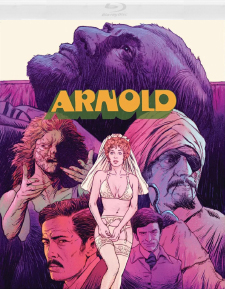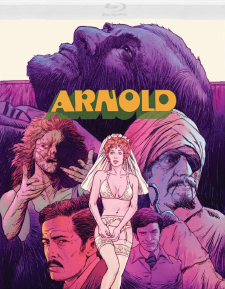Arnold (1973) (Blu-ray Review)

Director
Georg FenadyRelease Date(s)
1973 (October 31, 2023)Studio(s)
Fenady Associates/Bing Crosby Productions (Vinegar Syndrome)- Film/Program Grade: D+
- Video Grade: A-
- Audio Grade: A
- Extras Grade: B-
Review
Only the early-1970s could have produced a film the likes of Arnold (1973), a misbegotten horror comedy neither horrifying nor comical. Seemingly inspired, in part, by the superior The Abominable Dr. Phibes (1971), it wastes a good cast, working from an outrageous premise that makes no sense and which only gets more preposterous—not in a good way—as its thin story jerks forward.
All film comedy requires talent and finesse, but filmmakers often seem to think horror-comedy is an exception requiring no special skills, and that any combination of horror and comedy will somehow work. Writers Jameson Brewer and John Fenton Murray were primarily television writers and, before that, wrote cheap B-movies and shorts. They worked in every conceivable genre except horror films—sports movies, sitcoms, Saturday morning kids shows, jungle films, Westerns, etc. Their screenplay exhibits no understanding of the genre at all.
Set in present-day England somewhere near Liverpool, the story opens with voluptuous Karen (Stella Stevens) marrying her recently deceased lover, Lord Arnold Dwellyn (Norman Stuart), no matter that he’s a corpse. Prior to his death, Arnold arranged to have his preserved body kept in an open, high-tech casket, complete with automatic recliner and tape deck. On the tape deck Arnold’s pre-recorded voice (an uncredited Murray Matheson) reads his own last will and testament. Karen inherits the bulk of his estate, but must stay by Arnold’s side—permanently.
This does not sit well with Arnold’s greedy relatives and hangers-on: spiteful widow Lady Jocelyn (Shani Wallis, who also sings the not-good title tune); sneering younger brother Robert (Roddy McDowall), secretly also Karen’s lover; aloof solicitor-cousin Douglas Whitehead (Patric Knowles) and his conniving clerk, Evan Lyons (Farley Granger); and family servant Dybbi (Jamie Farr in a non-speaking part but plenty loud in a mauve Nehru jacket, turban, hook hand, and facial scar). Only Arnold’s dotty sister Hester (Elsa Lanchester) seems pleased with the arrangement. One-by-one they’re gruesomely murdered off, seemingly by the dead Arnold himself.
Bing Crosby had a mildly successful production company, with two certifiable hit TV shows—Ben Casey and Hogan’s Heroes—Der Bingle expanding into theatrical features in the early-‘70s. BCP’s biggest success was the vigilante thriller Walking Tall (1973) but, after that, its best-remembered film is the unusual thriller Willard (1971), about a hopeless introvert who raises pet rats to kill people. Wildly profitable, it prompted more horror films at BCP, which mostly released through minor distributor CRC, the sadly depleted company formerly behind the great Cinerama films. Arnold was apparently made back-to-back with the non-comedy Terror in the Wax Museum (1973), which shares the same production team and actors Lanchester (also in Willard), Knowles, Wallis, and Ben Wright, who played the constable in that but in Arnold is demoted to handyman.
The premise of Karen marrying a corpse is admirably outlandish but makes no sense. She’s supposed to be Arnold’s mistress, he being married to Lady Jocelyn. The writers seem to think death somehow unbinds Arnold from his legal wife; she becomes a widow, and he (or his corpse) is free to marry Karen. Huh?
I’d also venture to guess neither Jameson Brewer and John Fenton Murray ever got within a thousand miles of Great Britain. The England depicted in Arnold is laughably unreal. Portions of the story take place in what’s supposed to be an emblematic English pub. Excusing the fact the Liverpudlian barmaid (Wanda Bailey, former Golddigger on The Dean Martin Show) speaks with a Cockney accent, why is she dressed like Heidi of the Alps? At the pub, John McGiver, in a trivial, embarrassing role, plays a barfly billed in the credits as “Governor.” In the movie, various characters call him that, as if it were his name, or maybe his title. It’s as if Brewer or Murray once saw a British film where the term “guv’nor” was used and chose to repeat it here, without understanding its definition in British English.
Their “anything goes” method of plotting extends to the apparently endless cassette tapes Arnold recorded before his death, all of which magically anticipate every little gesture, comment, and movement of his greedy relatives at every moment. It’s a small point, yet so absurdly impossible it exposes the writers as extraordinarily lazy and unimaginative.
Further, Arnold has no sense of atmosphere. The back cover text calls it a “glorious nod to the old dark house chillers so popular during the Golden Age of Hollywood” but, visually, the film looks less like, say The Uninvited, than an extended episode of TV’s Night Gallery. And one of the Jack Laird-written segments at that. I haven’t seen Terror in the Wax Museum, but I wouldn’t be surprised if set components were repurposed to save money. Arnold was shot entirely on soundstage sets with no actual exteriors.
The cast tries their best with the weak (and illogical) material, particularly Stella Stevens, who against all odds is not embarrassing. Even Norman Stuart is impressively lifeless as Arnold. (Why Norman Stuart, a respected dialogue director more than an actor, didn’t dub Arnold’s speaking voice is a mystery. Stuart’s only other role of note was as a Vulcan elder in Star Trek: The Motion Picture.)
Vinegar Syndrome’s Blu-ray is derived from a 4K scan of a 35 mm interpositive (as opposed to the original camera negative, the go-to source when usable). It looks very good, not pristine. Presented in 1.85:1 widescreen, the image is a little grainy and soft at times but certainly far better than the film has looked since it was new, with good flesh tones and decent contrast. The Region “A” disc has DTS-HD Master Audio 2.0 mono sound, also good, with optional English subtitles.
Supplements consist of a new audio commentary by The Projection Booth Podcast co-host Mike White. It’s of the unscripted viewing party variety with some fairly long stretches of silence. Samm Deighan’s new video essay, The Gothic Horror Comedy in Hollywood, focuses less on Arnold and is more an overview of the genre, loaded with film clips and images dating back to the early silent era.
Judging from User Reviews on the IMDb and elsewhere, I’m glad Arnold has found lots of admirers a half-century since its release, but I sure ain’t one. As tedious as it is preposterous, Arnold can be safely avoided by all save die-hard genre fans.
- Stuart Galbraith IV

